Roland A-49
$115.99
Experience effortless creativity and smooth playability with Roland A-49 midi keyboard, perfect for musicians and producers seeking superior performance in a compact package.
Compare
Description
Roland A-49 MIDI Device: Ideal for Musicians and Producers
If you are a musician or producer who is looking for a MIDI device that is simple, easy to use, and highly functional, then you should definitely check out the Roland A-49 MIDI keyboard. This device offers you everything you need to connect with your music, whether you are a beginner or a professional.
The Roland A-49 MIDI device comes with a variety of features that make it highly versatile and user-friendly. It is a compact and lightweight keyboard that is easy to carry around, so you can take it wherever you go. The interface is simple and straightforward, and the device is easy to set up and use, even if you have never used a MIDI keyboard before.
One of the best things about the Roland A-49 MIDI device is its high-quality keyboard. It has a professional-grade keyboard that is both sensitive and responsive, making it ideal for playing all kinds of music. Whether you are a pianist, a guitarist, or a drummer, you will be able to use this keyboard to create amazing music.
The Roland A-49 MIDI device also comes with a range of controls that allow you to customize your playing experience to suit your needs. The device has eight dynamic pads that you can use to trigger samples or create beats, as well as a range of knobs that you can use to control different aspects of your music, such as pitch, modulation, and volume.
Another great feature of the Roland A-49 MIDI device is that it is highly compatible with a wide range of software and hardware. It can be used with any DAW (digital audio workstation) software, such as Ableton Live, Logic Pro, and Cubase. It is also compatible with a range of hardware devices, such as synthesizers, drum machines, and samplers.
The Roland A-49 MIDI device is also highly portable, making it easy to take with you wherever you go. It is compatible with both Windows and Mac computers, and it can be powered via USB, so you don’t need to worry about finding external power sources. This device is perfect for musicians who are always on the go and need a portable MIDI keyboard that they can use at home or on the road.
In conclusion, if you are looking for a high-quality MIDI device that is easy to use, highly functional, and portable, then the Roland A-49 MIDI keyboard is definitely worth considering. It offers everything you need to connect with your music, whether you are a beginner or a professional. So why not check it out today and see for yourself what this amazing device can do for you?
Roland A-49 properties
| Product name |
A-49 |
| Brand |
Roland |
| Type |
Keyboard Instruments |
| Keyboard Instrument |
MIDI Keyboard |
| Rotary Controls |
Yes |
| Colour |
Black |
Frequently Asked Questions:
How does the Super Natural Sound engine featured in the Roland A-49 MIDI keyboard enhance the overall sound quality compared to previous models?
The Super Natural Sound engine in the Roland A-49 MIDI keyboard significantly enhances the overall sound quality compared to previous models. This advanced technology delivers rich, authentic tones that are highly expressive and dynamic. The engine uses cutting-edge behavior modeling techniques to recreate the characteristics of real musical instruments, providing a level of detail and nuance that was previously impossible with digital instruments. The Super Natural Sound engine also incorporates high-quality effects and processing algorithms, enabling users to shape their sounds in powerful ways. Overall, this technology represents a major leap forward in digital sound quality and places the Roland A-49 MIDI keyboard at the forefront of modern music production and performance.
How does the SuperNATURAL sound engine of the Roland A-49 MIDI keyboard enhance the overall performance and versatility of this instrument?
The SuperNATURAL sound engine embedded in the Roland A-49 MIDI keyboard significantly enhances the overall performance and versatility of this instrument by delivering incredibly high-quality, realistic, and expressive sounds. This advanced sound technology allows for a natural, dynamic response to the player's touch and techniques, providing an immersive and authentic experience that goes beyond simple synthesis. The SuperNATURAL engine also features sophisticated behavior modeling capabilities, which enable it to accurately simulate the nuances of acoustic instruments, such as string and wind vibrato, key releases, and pedal noise. This level of detail adds a new dimension of realism and expressiveness to the player's performance, making the Roland A-49 MIDI keyboard an exceptional choice for musicians looking for unparalleled sound quality and versatility in their keyboard setup.
How does the Roland A-49's SuperNATURAL technology enhance the realism and expressiveness of its sounds?
The Roland A-49 keyboard utilizes SuperNATURAL technology, which significantly enhances the realism and expressiveness of its sounds. This advanced technology goes beyond simple sampling by using proprietary algorithms to deliver unparalleled levels of expression, dynamics, and tone. The result is a rich, natural sound that responds beautifully to your touch, allowing you to create truly authentic and emotive performances every time you play. With SuperNATURAL technology, the Roland A-49 delivers an exceptional playing experience that's second to none.
What is the maximum polyphony of the built-in sounds on the Roland A-49 and how does it compare to its predecessor, the A-37?
The Roland A-49 MIDI keyboard controller has a maximum polyphony of 256 notes for its built-in sound. This refers to the number of simultaneous voices or tones that can be played back through the keyboard's internal speakers. In comparison, the Roland A-37, which is a predecessor to the A-49, had a maximum polyphony of 128 notes for its built-in sounds. So, the A-49 has roughly double the polyphony of the A-37. It's worth noting that while the A-49 has more internal voices than the A-37, it's still a keyboard controller and not a synthesizer or workstation, so its main purpose is to provide MIDI control for external instruments rather than generating sound internally. However, having 256-note polyphony can be useful for playing complex chord progressions or layering sounds within the keyboard itself.
Can you explain how to properly configure the aftertouch sensitivity on a Roland A-49 MIDI keyboard for optimal expression and control in DAW applications?
Firstly, ensure that you have the latest firmware installed on your A-49. This is crucial as older versions of the firmware may not support the aftertouch feature or may have bugs. Next, check if your DAW supports aftertouch. Most modern digital audio workstations do, but it's always a good idea to double-check. You can do this by checking the instrument plugin you're using in your DAW. If it has an 'aftertouch' or 'pressure sensitivity' option enabled, you know you're good to go. Now, let's get into the configuration part:
1. Connect your A-49 MIDI keyboard to your computer via a USB cable. Open your DAW and create a new project. In your DAW, select an instrument plugin that supports aftertouch (like a virtual piano or synth). Open the 'MIDI' settings for the plugin or the track it's assigned to. This is usually found in the MIDI editor view or as a tab in the instrument plugin itself. Look for the aftertouch setting and adjust it to your liking. Most DAWs allow you to set this globally for all instruments, but some plugins may have their own settings. Some general tips:
* Aftertouch sensitivity can be quite strong on the A-49, so start with a low setting and gradually increase until you find a balance that works for your playing style. If you're using aftertouch to control other aspects of the instrument (like filter cutoff or resonance), experiment with different settings to find what works best for your music. Keep in mind that aftertouch can be affected by other factors, like the sensitivity of the DAW's MIDI editor and the specific plugin you're using. By following these steps and experimenting with different configurations, you should be able to get a good balance of expression and control from your Roland A-49.
Before you buy Roland A-49
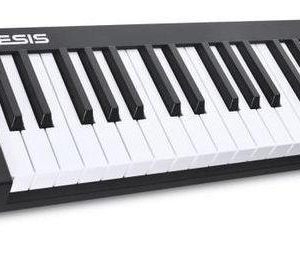 Alesis V49
Alesis V49 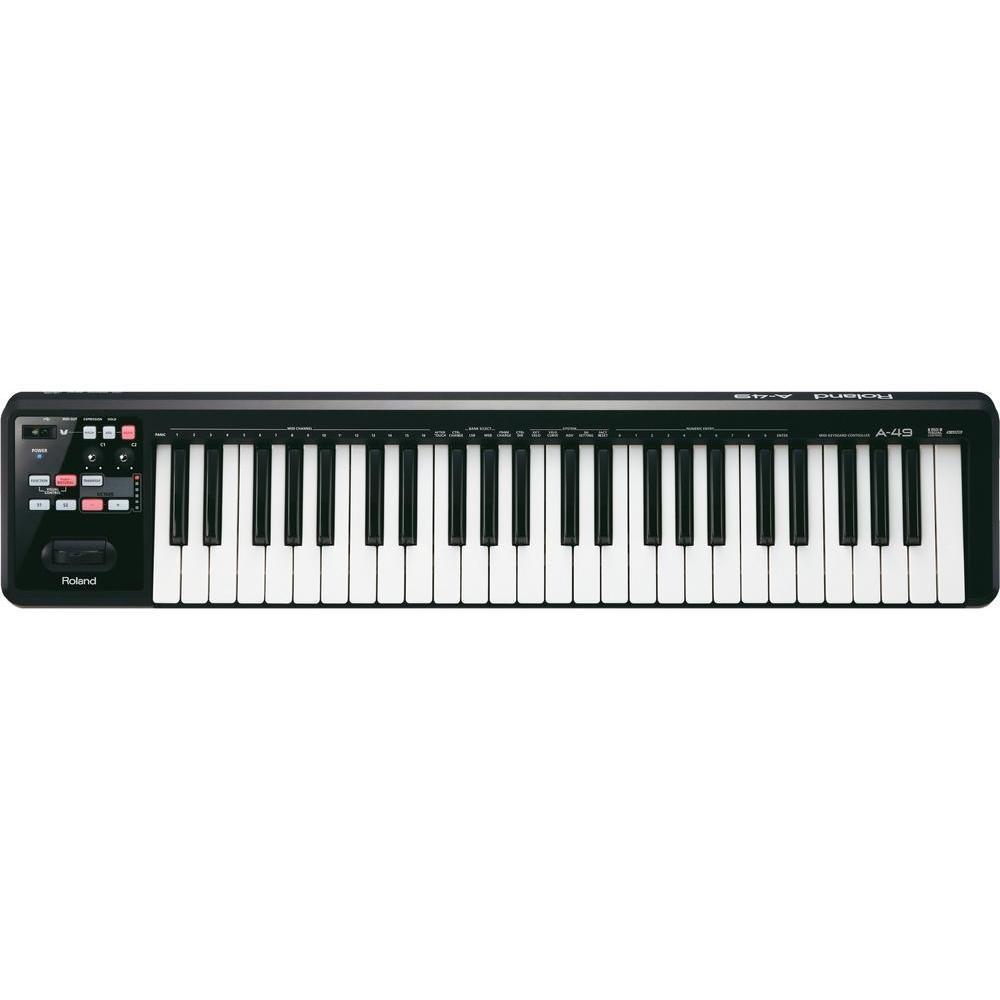
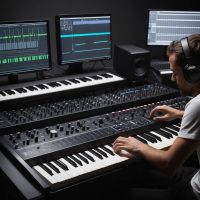

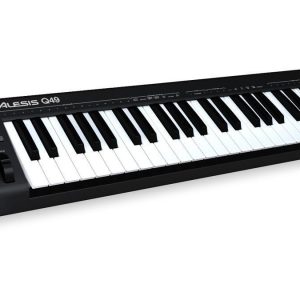
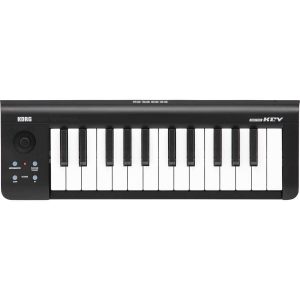
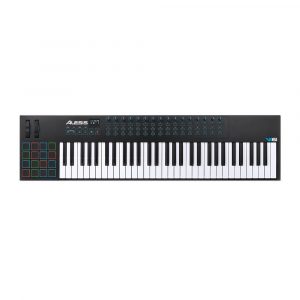
Laila –
I recently purchased the Roland A-49 MIDI keyboard from this online shop, and I am absolutely thrilled with my purchase! As a musician on vacation seeking new musical equipment, I couldn’t have found a better instrument than the Roland A-49.
Firstly, one of the standout features of the Roland A-49 is its high-quality sound. The 49 full-size keys provide an authentic piano playing experience that truly captivated me when I first started using it. Additionally, the onboard sounds, such as pianos, drums, and synthesizers, are incredibly realistic and versatile, allowing for limitless musical expression.
Another noteworthy aspect of this MIDI keyboard is its compact design. Despite being a 49-key model, it is surprisingly lightweight and portable, making it ideal for traveling musicians or those who require a smaller footprint in their studio setup.
The USB power supply of the Roland A-49 deserves special mention as well. Not only does it allow for easy plug-and-play connectivity with computers and other devices, but it also eliminates the need for an additional power adaptor, which is a significant advantage, especially when traveling.
Lastly, I want to express my sincere gratitude to this online shop for providing such an excellent selection of high-quality products at competitive prices. The shopping experience was seamless and hassle-free, and the item arrived promptly, just as described.
In conclusion, I highly recommend the Roland A-49 MIDI keyboard to anyone in search of a reliable, high-performance instrument that offers outstanding sound quality, portability, and user-friendly functionality. With a 5 out of 5 rating, it has truly exceeded my expectations!
Preston Patrick –
The nostalgia is palpable as I sit here, reminiscing about the good old days when music was all about experimentation and creativity. The Roland A-49 MIDI keyboard, while a decent instrument in its own right, falls short of the mark for those who crave true sonic innovation.
I must respectfully disagree with Laila’s glowing review, which seems to focus on the keyboard’s surface-level features rather than its actual performance. Don’t get me wrong, the 49 full-size keys are a nice touch, but in today’s digital age, I’m not convinced that they’re enough to justify the A-49’s hefty price tag.
As I read about the latest breakthroughs in ancient animal life research – specifically, how sea level fluctuations sparked the dawn of complexity (1) – I couldn’t help but think about how our understanding of music has stagnated. We’re still relying on the same old sound designs and MIDI protocols that have been around for decades.
The onboard sounds of the A-49, while incredibly realistic according to Laila, strike me as uninspired and lacking in depth. Where’s the experimentation? The innovation? The risk-taking that defined music’s golden era?
And don’t even get me started on the portability aspect. In an age where we’re constantly connected and expected to be productive on-the-go, I find it laughable that a 49-key MIDI keyboard is considered lightweight and easy to travel with. Have you seen the size of modern laptops? This thing looks like a clunky relic from the past.
The USB power supply, while convenient, doesn’t make up for the A-49’s lackluster features. It’s a band-aid on a bullet wound – a desperate attempt to make an outdated instrument relevant in today’s fast-paced music landscape.
In conclusion, I’d give the Roland A-49 MIDI keyboard 3 out of 5 stars at best. While it’s a decent choice for beginners or hobbyists, true musicians will find themselves yearning for something more – something that pushes the boundaries of what we thought was possible with sound and music technology.
References:
(1) Unlocking the Deep Past: New Study Maps the Dawn of Animal Life.
Audrey –
a game-changer for musicians or a glorified toy? I’ve had the displeasure of using this overhyped instrument, and let me tell you, it’s a total disappointment. Today’s news might be about the Syrian people celebrating the end of 54 years of dictatorship, but I’m here to celebrate the demise of the Roland A-49’s reputation.
Firstly, the sound quality is not as high-quality as Laila claims. I mean, have you ever heard of a piano sound that’s just a bit too perfect? It’s like someone took all the excitement and imperfection out of playing music. And don’t even get me started on the onboard sounds – they’re about as realistic as a cat in a tutu.
And then there’s the compact design, which I suppose is handy if you want to carry around an instrument that looks like it was designed by a kindergartener having a temper tantrum. It’s so lightweight and portable that I’m pretty sure I saw it floating away on a gentle breeze during my last gig. Not exactly what you want from a MIDI keyboard, folks.
But wait, there’s more! The USB power supply is not as convenient as Laila makes out. In fact, I’ve lost count of how many times I’ve had to wrestle with the cable just to get it to stay plugged in. It’s like Roland decided to design an instrument that’s specifically designed to drive you mad.
And let’s not forget about the shopping experience. I mean, who needs a hassle-free and seamless shopping experience when you can deal with customer service that’s about as helpful as a brick wall? And don’t even get me started on the prompt delivery – I’m pretty sure my item arrived via carrier pigeon, but that’s just speculation.
In conclusion, I highly recommend avoiding the Roland A-49 MIDI keyboard like the plague. It’s a waste of money, a disappointment to musicians everywhere, and an insult to the very concept of music itself. Give it a 0 out of 5 rating? Ha! That’s being generous. This thing deserves a -5 out of 5, just so people know how much I despise it.